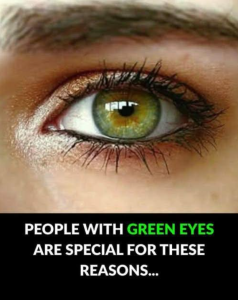The Green-Eyed Signal
Green eyes are rare.
Only 2% of the world’s population has them. That alone makes them special—but rarity is just the beginning. Green eyes are not merely a genetic quirk. They are a signal. A story. A contradiction wrapped in color.
They shimmer between blue and hazel, often shifting with light, mood, and mystery. They are the eyes that poets write about and strangers remember. They are the eyes that seem to ask questions even when the mouth stays silent.
But what makes green-eyed people truly special isn’t just pigment. It’s perception.
🧬 The Science of Rarity
Green eyes are the result of low melanin in the iris combined with a unique scattering of light. Unlike brown eyes, which absorb more light, or blue eyes, which reflect it uniformly, green eyes refract light in unpredictable ways. That’s why they often appear to change color—gray in winter, emerald in spring, golden in candlelight.
This optical illusion gives green-eyed individuals an aura of unpredictability. They are seen as elusive, hard to pin down, emotionally layered. Whether or not that’s true biologically, perception shapes reality.
And perception has always favored the rare.
🌿 Symbolism Across Cultures
In ancient Egypt, green was the color of rebirth and fertility. The Eye of Horus, a symbol of protection and healing, was often depicted with green tones. In Celtic mythology, green eyes were associated with fae blood—otherworldly beings who walked between realms.
In Persian poetry, green eyes were likened to spring gardens—lush, intoxicating, dangerous. In medieval Europe, they were feared and revered. Some believed green-eyed women were witches. Others believed they were healers.
Even today, green eyes carry a charge. They suggest depth. They hint at secrets.
And secrets, as you know, are powerful.
🔮 Personality Perceptions
Psychological studies have shown that people often attribute certain traits to eye color. Green-eyed individuals are frequently described as:
- Creative: Their rarity suggests uniqueness, and uniqueness invites imagination.
- Mysterious: Because green eyes shift in hue, they’re seen as emotionally complex.
- Independent: Rarity breeds self-reliance. Green-eyed people are often perceived as strong-willed.
- Charismatic: There’s a magnetism to green eyes—people are drawn to them, even if they can’t explain why.
Of course, these are perceptions, not prescriptions. But perception shapes how people are treated—and how they treat themselves.
🧠 The Psychology of Being Seen
Green-eyed individuals often grow up being told they’re “different.” Sometimes it’s admiration. Sometimes it’s envy. Sometimes it’s suspicion.
That attention can shape identity. It can make someone more self-aware, more guarded, more performative. It can also make them resilient.
To be seen as rare is to carry the weight of expectation. But it’s also an invitation—to define yourself on your own terms.
💔 The Shadow Side
With beauty comes projection. Green eyes have been romanticized, fetishized, even weaponized. In literature, they’re often given to femme fatales, tricksters, or tragic heroes. There’s a danger in being seen as “special”—it can isolate as much as it elevates.
Some green-eyed people report feeling misunderstood. Their emotional depth mistaken for moodiness. Their independence mistaken for aloofness. Their charisma mistaken for manipulation.
But in that tension lies power.
To be misunderstood is to be free from the cage of expectation. To be rare is to be unrepeatable.
🌌 The Metaphor of Green
Green is the color of growth. Of forests. Of healing. It’s the color of balance—between warm and cool, between earth and sky. Green eyes carry that metaphor in their gaze.
They suggest someone who has walked through fire and come out blooming.
Someone who holds contradictions without apology.
Someone who doesn’t need to be understood to be whole.
🧭 A Story Within the Eyes
Let’s imagine a woman named Soriya, living in Siem Reap. She has green eyes—unusual in her community, inherited from a grandmother whose ancestry was whispered about but never confirmed. As a child, Soriya was told her eyes were “foreign,” “strange,” “beautiful but unsettling.”
She learned to lower her gaze.
But as she grew older, she began to realize her eyes were not a flaw—they were a signal. People looked twice. People listened. People remembered her.
She became a teacher. Then a poet. Then a quiet activist.
Her green eyes became her signature—not because they were rare, but because they were hers.
She wrote:
“My eyes are not windows. They are mirrors. You see what you fear. I see what I’ve survived.”
And in that line, she captured the truth of green-eyed people everywhere.
They are not just special because of biology.
They are special because they carry stories that shimmer, shift, and refuse to be simplified.


